The Different Types of Baldness: Understanding Causes and Solutions for Hair Loss

Baldness is a condition that is reported to affect a large number of people across the world. Baldness is not only the hair; it is the confidence, the appearance, and the health. Baldness is a typical process that is linked with the aging of the individual, however, it is not only one type of Baldness, nor is there only one way in which it occurs, nor is there only one treatment for it. Knowing the types can assist you in identifying how to deal with or even cure your Baldness. Here, they explain the root cause of the different types of Baldness and which solution may help you regrow your hair.
What is Baldness? (Problem)
Baldness, also known as alopecia, is the partial or complete loss of hair on the scalp or other areas of the body. While it is most commonly associated with aging, baldness can occur at any age and affect men, women, and even children. The severity of hair loss ranges from thinning patches to complete baldness, depending on the type and cause.
Why It Matters (Agitation)
Imagine waking up one day and noticing that your hair is thinning or falling out in patches. For many, this realization can be emotionally overwhelming. The fear of losing hair often triggers stress, anxiety, and even depression. Since hair plays a crucial role in personal identity and social interactions, baldness can deeply affect a person’s self-esteem. However, understanding the different kinds of baldness and their causes can help you take action before it’s too late.
The Different Types of Baldness
There are several types of baldness, each with distinct causes. Here are the most common forms:
1. Androgenetic Alopecia (Male and Female Pattern Baldness)
 Hair loss stages, androgenetic alopecia male and female pattern. Steps of baldness vector infographic in a flat style with a man and a woman. MPHL and FPHL[/caption]
Hair loss stages, androgenetic alopecia male and female pattern. Steps of baldness vector infographic in a flat style with a man and a woman. MPHL and FPHL[/caption]
Androgenetic alopecia, or pattern baldness, is the most common type of hair loss. It affects about 50 million men and 30 million women in the United States alone. This type of baldness is largely hereditary and results from a combination of genetics and hormonal changes, particularly the effect of dihydrotestosterone (DHT), a derivative of testosterone.
- In Men: Male pattern baldness often begins with a receding hairline or thinning at the crown, eventually leading to partial or full baldness.
- In Women: Female pattern baldness tends to cause thinning across the scalp, particularly at the parting line, without receding hairlines.
Case Study: A 2020 study published in the Journal of the American Academy of Dermatology found that men who start losing hair at an early age (before 30) have a higher chance of developing complete baldness by age 50, but treatments like minoxidil and finasteride can help slow this process.
2. Alopecia Areata

Alopecia areata is an autoimmune disorder where the body’s immune system mistakenly attacks hair follicles, causing hair to fall out in small patches. It can occur suddenly, and in some cases, hair may grow back only to fall out again later.
- Symptoms: Circular patches of hair loss, most often on the scalp but sometimes on the eyebrows, beard, or other body parts.
- Treatment: Corticosteroid injections, topical immunotherapy, and even oral medications can help manage the immune response and promote hair regrowth.
3. Telogen Effluvium

Telogen effluvium is a temporary form of hair loss triggered by stress, illness, or hormonal changes. It’s common after events like childbirth, surgery, or severe illness (like COVID-19). Hair falls out during the “telogen” or resting phase of the hair growth cycle, but the good news is that it usually grows back once the underlying cause is resolved.
- Triggers: Emotional stress, crash dieting, childbirth, severe infections, or medication.
- Recovery: Telogen effluvium usually resolves on its own within 6 to 12 months, especially once the trigger is removed. Maintaining a healthy diet rich in vitamins can speed up recovery.
Fact: The American Academy of Dermatology notes that about 40% of women experience telogen effluvium postpartum (after giving birth).
4. Traction Alopecia

Traction alopecia is caused by physical stress on the hair follicles due to tight hairstyles, such as ponytails, braids, or extensions. Over time, this can lead to permanent hair loss if the hair is pulled too tightly for extended periods.
- Prevention: Avoiding tight hairstyles and using gentle, non-damaging hair accessories can prevent traction alopecia.
- Treatment: In the early stages, hair loss is reversible by reducing the tension on the scalp, but prolonged stress can result in permanent follicle damage.
5. Cicatricial Alopecia (Scarring Alopecia)

Cicatricial alopecia, or scarring alopecia, is a rare condition where inflammation destroys hair follicles, leading to irreversible hair loss and scarring. It can be caused by various inflammatory skin conditions, including lichen planopilaris and frontal fibrosing alopecia.
- Symptoms: Scalp redness, scaling, and even pain or tenderness in affected areas.
- Treatment: Early diagnosis is key. Anti-inflammatory medications like corticosteroids or immunosuppressants can help reduce the inflammation and slow the progression.
6. Anagen Effluvium

Anagen effluvium is a rapid hair loss condition, often triggered by chemotherapy, radiation therapy, or exposure to toxic chemicals. Since chemotherapy targets fast-growing cells (like hair follicles), patients often experience extensive hair loss within weeks of treatment.
- Symptoms: Sudden and widespread hair loss, especially on the scalp, eyebrows, and body.
- Treatment: While hair usually regrows after treatment ends, cold caps (scalp cooling therapy) can sometimes prevent hair loss during chemotherapy.
Treatments for Baldness: What Works?
Now that we’ve explored the types of baldness, let’s dive into potential treatments. The good news is, depending on the cause, hair loss can often be managed or even reversed.
- Medications:
- Minoxidil (Rogaine): A topical solution that stimulates hair growth, effective for androgenetic alopecia.
- Finasteride (Propecia): An oral medication that reduces DHT levels, slowing hair loss in men.
- Hair Transplant Surgery: For those with significant hair loss, hair transplants can offer permanent results by moving hair from one part of the scalp to another.
- Laser Therapy: Low-level laser therapy (LLLT) is an emerging treatment that may stimulate hair growth for both men and women with pattern baldness.
- Lifestyle Changes: Eating a balanced diet rich in vitamins and minerals, like biotin, zinc, and iron, can improve hair health. Reducing stress and avoiding tight hairstyles can also prevent further hair loss.
FAQs About Baldness
- Can baldness be cured? While there is no permanent cure for most types of baldness, many treatments can effectively manage or slow down hair loss.
- Is hair loss hereditary? Yes, androgenetic alopecia (pattern baldness) is hereditary and is the most common type of hair loss.
- How can I prevent baldness? Maintaining a healthy lifestyle, managing stress, and avoiding damaging hairstyles can help prevent certain types of hair loss.
- Does stress cause hair loss? Yes, stress can trigger telogen effluvium, a temporary form of hair loss.
- Can diet impact hair health? Absolutely! A diet rich in vitamins, minerals, and proteins is essential for maintaining healthy hair.
- Are there natural remedies for hair loss? Some people find success with natural remedies like essential oils (rosemary, peppermint) and scalp massages, though their effectiveness varies.
Conclusion
Baldness may seem inevitable for some, but understanding the type of hair loss you’re experiencing can help you take action. From hereditary causes like androgenetic alopecia to autoimmune conditions like alopecia areata, each type of baldness has its own treatment options. Remember, early intervention is key, so if you’re noticing hair loss, don’t wait—talk to a dermatologist today.
